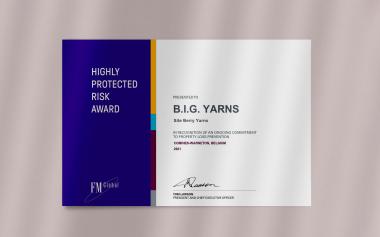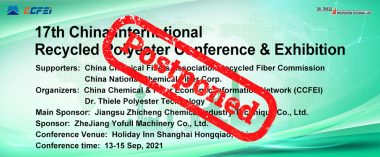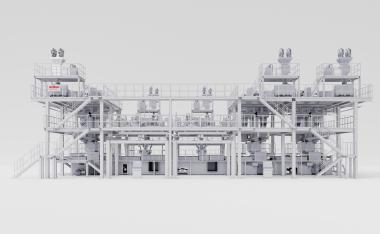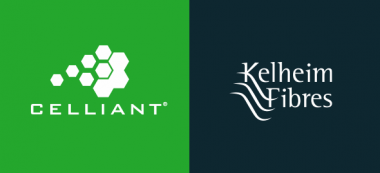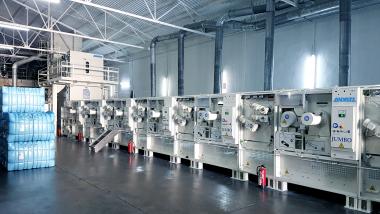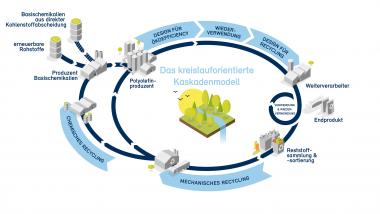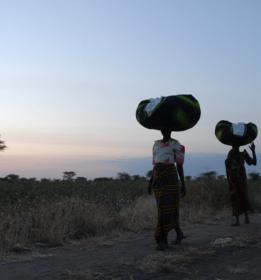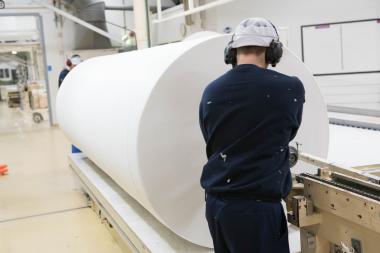HUESKER führt ersten Hochleistungsroboter ein
- Robotik für mehr Produktivität, Flexibilität und beste Arbeitsbedingungen
- Tonnenschwere Entlastung für die Mitarbeiter in der Garnproduktion
Gemeinsam mit ABB, einem Pionier in der Robotik und Automation, entwickelte die HUESKER-Gruppe - einer der weltweit führenden Hersteller von technischen Hochleistungstextilien für Tiefbau, Agrarwirtschaft, Industrie und Leichtbau- einen Prototyp, der gezielt für die Handhabung und Palettierung schwerer Garnrollen eingesetzt wird.
In einer seiner Produktionsanlagen für Basisgarne, die teilweise zu 100 Prozent aus recycelten Materialien stammen, setzt die HUESKER Gruppe jetzt auf die Unterstützung eines Roboters.
„Wir haben uns in jüngster Zeit verstärkt Gedanken darüber gemacht, wie wir Robotik und Automatisierung bestmöglich für uns und unser Personal nutzen können. Bei der Handhabung und Palettierung von Garnrollen, die bis zu 15 Kilogramm auf die Waage bringen, lagen die Vorteile sofort auf der Hand: Roboter entlasten unsere Mitarbeiter von dieser anstrengenden Tätigkeit und geben ihnen die Möglichkeit, höherwertigere Aufgaben zu übernehmen“, betont Dr. F.- Hans Grandin, Geschäftsführender Gesellschafter der HUESKER Gruppe.
In Zusammenarbeit mit dem Unternehmen ABB wurde ein Roboter implementiert, der neben hoher Leistungsfähigkeit auch besonders niedrige Gesamtbetriebskosten aufweist. Aus drei Produktionsmaschinen mit jeweils zwei Entnahmemulden nimmt der Roboter die fertigen Garnrollen zuverlässig auf. Die Mulden befinden sich weit oben und unten –unergonomische Positionen für die Mitarbeiter, die diese Tätigkeit bisher verrichtet hatten. Hinzu kommt: Je nach Produktionsauftrag sind die Garnrollen unterschiedlich in Durchmesser und Gewicht, was für den auf bis zu 150 Kilogramm ausgelegten Roboter kein Problem darstellt. Im Schnitt nimmt er dem Mitarbeiter rund 2,5 Tonnen pro Tag ab.
Auch filigranere Arbeiten kann der Roboter ausführen: Jede fertig produzierte Garnrolle hat ein offenes Fadenende, das gesichert werden muss, um ein Abspulen auf der Palette zu verhindern. Dafür gibt der Roboter die Rolle an eine Bearbeitungsstation, an der ein Klebeetikett angebracht wird, das den Faden fixiert. Zudem hat der automatische Spulenwechsel zur Folge, dass ein so genannter Reservefaden übersteht, welcher in den folgenden Verarbeitungsschritten jedoch nicht benötigt wird. Um ihn zu entfernen, fährt der Roboter die Spule an eine weitere Vorrichtung, wo der Faden mit einem Heizdraht abgebrannt und abgesaugt wird.
Für die Palettierung setzt der Roboter die Spulen hochkant und auf eine Palette. Sobald eine Ebene voll bepackt ist, entnimmt er eine Zwischenlage aus einem Magazin und legt sie passgenau auf. Anschließend folgt das Bestücken der Maschinen mit Leerhülsen, um so den Produktionsbetrieb zu unterstützen.
Die Mitarbeiter überwachen und assistieren sporadisch, etwa wenn eine fertige Palette abtransportiert, Zwischenlagen aufgefüllt oder Leerhülsen nachgefüllt werden müssen. Diese Aufgaben nehmen nur wenig Zeit in Anspruch und fallen pro Schicht höchstens ein- bis zweimal an. Somit läuft die gesamte Anlage, bis auf diese kurzen Unterbrechungen, nahezu autonom.
Nach erfolgreicher Implementierung der ersten Automatisierungsanlage sieht HUESKER viel Potenzial darin, Robotik für weitere Anwendungen zu nutzen – etwa für die der Garnproduktion direkt vorgelagerten Prozesse. Auf diese Weise werden durchgängige Automatisierungslinien geschaffen, die dem Unternehmen helfen, Produktivität und Flexibilität zu steigern sowie die Arbeitsbedingungen für seine Mitarbeiter weiter zu verbessern.
Huesker











